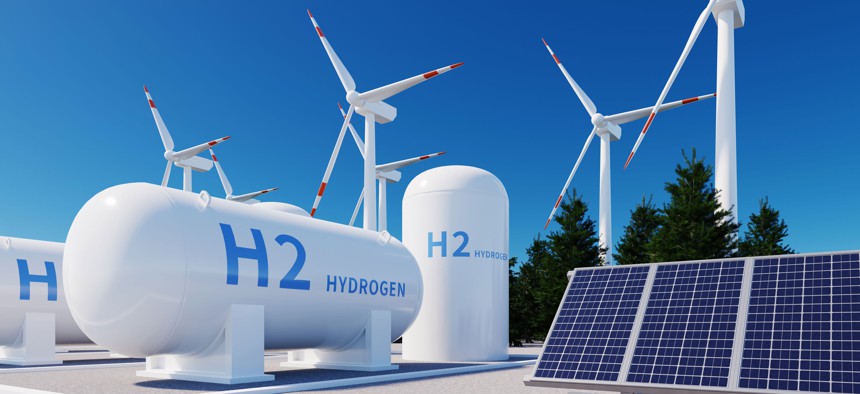Energy
Opinion: Hydrogen energy sounds too good to be true – because it is
Although it is touted as a viable alternative to fossil fuels, research shows that it is not the climate change cure-all many have made it out to be.

A hydrogen energy storage system alongside a solar power plant and wind turbines. Clean Air Council
At first blush, using hydrogen as an energy source sounds appealing. It’s the most abundant element in the universe, it can be used to replace fossil fuels and it doesn’t emit any greenhouse gas pollution when it’s burned. Gov. Josh Shapiro has made it an early priority in his environmental agenda, pledging to secure competitive federal grants to construct at least one “regional hydrogen hub” (there must be at least a 50% non-federal cost share).
The reality is, hydrogen is not the climate change cure-all many have made it out to be. Pennsylvania residents – and the elected leaders who represent them – must better understand the full implications of hydrogen energy before committing to making it a major part of our communities and the commonwealth’s climate and energy policy.
President Joe Biden’s Bipartisan Infrastructure Law allocated $8 billion to the U.S. Department of Energy through September 2026 for the creation of regional clean hydrogen hubs across the country. Last fall, DOE issued a funding opportunity announcement for $7 billion of those funds to support six to 10 proposed hub projects. Full applications were due by April 7. DOE highlights heavy-duty transportation and steel manufacturing as end-use sectors where hydrogen can assist in decarbonization, as these sectors’ greenhouse gas emissions are challenging to abate through the use of clean, fossil-free electricity. For community members and elected officials, weighing the pros and cons of these hubs starts with understanding more about how hydrogen energy can be produced, and what those different production methods mean for impacts on our neighborhoods and environment.
Hydrogen does not exist freely in nature or Earth’s atmosphere, but it exists in great quantities combined with other elements. There are several ways to produce pure hydrogen for use as an energy source. “Gray” hydrogen is harvested from fossil gas through a process called steam methane reformation. “Blue” hydrogen would use the same process but be paired with carbon capture and sequestration technology. “Green” hydrogen is produced from water, as electrolysis powered by renewable electricity splits hydrogen atoms from the oxygen. Each has drawbacks and tradeoffs that warrant further study and consideration.
Gray hydrogen’s flaws are most apparent since it relies on traditional fossil fuel feedstock and infrastructure to access and transport the methane needed to produce the hydrogen. Methane is an extremely potent climate pollutant and it leaks across all segments during its production and transportation. The process of producing hydrogen from methane also generates significant carbon dioxide pollution.
Blue hydrogen would purportedly counteract the CO2 pollution that comes with gray hydrogen by capturing the carbon during SMR, transporting it via pipeline and injecting it deep underground. It does not address all the upstream leaks of methane that occur before that, though. Moreover, a recent study found that the carbon footprint of blue hydrogen is more than 20% greater than just directly burning methane gas or coal for heat. What’s more, the CCS technologies that would theoretically keep CO2 emissions in check have historically failed or underperformed and would be extremely energy-intensive, regardless. More than 80% of carbon capture projects nationwide have failed.
Green hydrogen has its shortcomings too – most notably, Pennsylvania simply does not produce enough renewable energy currently to devote it to hydrogen (in 2021, Pennsylvania generated just 3% of its in-state electricity from renewables). Using renewable energy to produce hydrogen is a much less efficient means of decarbonization when compared to, for example, direct electrification of a process using clean energy. We need to rapidly scale up our deployment of renewable energy to clean up our electric grid, but diverting that power to the relatively inefficient process of hydrogen production is a poor use of resources.
Not surprisingly, many fossil fuel companies have come out in favor of hydrogen – particularly gray and blue methods. On this front, it’s hard not to see these hydrogen hubs as yet another way to prop up fossil fuels and the pipelines, infrastructure and environmental hazards that have long come with them.
If the commonwealth is to secure a hydrogen hub, it would likely be built in Southwestern Pennsylvania, where methane gas drilling dominates. It’s an area that has been forced to bear the brunt of the fossil fuel industry’s harms and dangers for years, with each new fracking project or petrochemical facility built on the false premise of protecting jobs over protecting the planet.
At a minimum, voters there and throughout the state need to understand the true implications of a hydrogen hub. They must demand that their elected officials and Gov. Shapiro do the same. There are tough questions that need answers. How much new and existing fossil fuel infrastructure would be required? How will communities be protected? How will there be rigorous oversight and enforcement to ensure lifecycle emissions are actually reduced? Hydrogen may well have a beneficial, niche role to play in a decarbonized future, but there are better and more efficient ways to bring about sustainable and affordable energy solutions for Pennsylvania residents here and now.
Joseph O. Minott is the executive director and chief counsel at the Clean Air Council.
